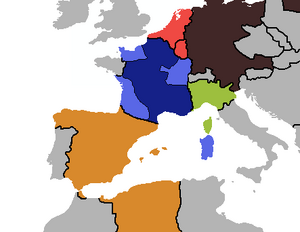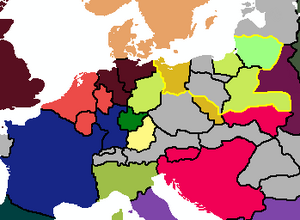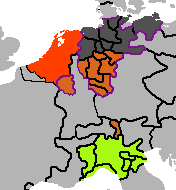Kingdom of Lombardy (English)
Timeline: Principia Moderni III (Map Game)
Regno d'Lombardia(Italian) Langobardiae Regnum (Latin)OTL equivalent: Duchy of Milan | |||||
|---|---|---|---|---|---|
|
|||||
| Map of Lombardy (green) in 1760, alongside the Netherlands, Westphalia, and other members of the Holy Roman Empire.
|
|||||
| Capital (and largest city) | Milan | ||||
| Other cities | Turin, Genoa, Verona, Bologna, Savona, Como, Zermatt, Lugano, Trento, Pavia, Parma, Modena, La Spezia, Bergamo, Ravenna, Venice, Bolzano, Pordenone, Udine, Vicenza, Merano, Trento, Rovereto, Treviso, Cremona, Pavia, Cuneo, Ivrea, Alessandria, Lecco, Monza, Veressa, Novara, Modena, Bologna, Massa, Ferrara, Padua, Rovigo, Pisa, Prato, Ravenna, Forli, Imola, Cesena, Lecco, Nice, Mentan, Sanremo, Chamonix and, Briancon | ||||
| Official languages | Italian | ||||
| Religion | Roman Catholic | ||||
| Government | Feudal monarchy | ||||
| - | King | Francesco Martini | |||
| Establishment | |||||
| - | Reformed into Kingdom | 1503 | |||
| - | Spanish Annexation | 1560 | |||
| - | Treaty of Toledo (Independence) | 1749 | |||
| Population | |||||
| - | census | 80.5 Million | |||
| Currency | Scudo | ||||
The Kingdom of Lombardy is a constituent state of the Holy Roman Empire in northern Italy. In 1503 it became its own nation.
History[]
It was created in 1503, following the merger of the Duchy of Milan, and its territories of Padua and Ravenna. The Kingdom of Lombardy arose from Milan, which had been created from a collection of twenty-six towns and a wide rural area of the middle Padan Plain, east of the hills of Montferrat. For much of its early existence, the duchy was separated from the sea and other nations by Savoy to the west, Venice to the east, the Swiss Confederacy to the north, and Genoa to the south. By the late fifteenth century, however, the duchy had grown to be one of the most powerful Italian states, outside of the Kingdom of Italy to the south. Milan took part in a successful invasion of Italy, granting the duchy control over most of northern Italy, while the Kingdom of Spain secured Italy proper. During the reign of Stephano the Great the duchy would be reformed into the Kingdom of Lombardy, and the region would experience one of its first golden ages. Lombardy served on the forefront of cultural innovation, as one of the leading patrons of the arts in Europe, becoming home to some of the continent's most renown renaissance painters and sculptors. In the late sixteenth century the Kingdom of Lombardy was invaded by its former ally Spain through Italy, being conquered by the House of Habsburg. Spanish rule would continue for the next century, under which the former Visconti family continued to grow influential in the area. In 1749 the last Spanish ruler of Lombardy would be defeated in the War of the Grand Coalition, in which Lombardy managed to secure its independence. Giovanni Visconti was appointed leader of all Italian forces against Spain, leading allied forces to victory in northern Europe, alongside other great generals such as Eugene of Savoy. After the war's conclusion with the Treaty of Toledo, Leopold II von Habsburg of the Netherlands and Westphalia was appointed king in Lombardy, with Giovanni Visconti as regent. An agreement soon after the war would be signed, which placed Giovanni's son (Leopold's grandson), Stephano von Habsburg-Visconti, as heir apparent to the throne of Lombardy. This would mark the return of the Visconti to power in Lombardy. In 1898 Giovanni Martini becomes the king. The king's son Mario is born in 1900. in 1907 our nation joined the Holy League. In Great War we invade France. In Treaty of Stuttgart we annex several chunck of southeastern France and Corsica. Lombardy temporarily occupies the Autonomous Province of Sardinia for ten years. Antonio is born in 1924. Giovanni dies in 1932 at the age of 64. Antonio's first son Francesco in 1946. 1952 WW2 ends and peace can established. Francesco's first son Alfonso is born in 1969. Mario dies in the year 1970 at the age of 70. Sergio is born in 1993. Antonio dies at the age of 69.
Military[]
Transportation Prior to the invention of the motorized transport, combatants were transported from by wagons, horses and by marching. With the advent of locomotives, large groups of combatants, supplies, and equipment were able to be transported faster and in larger numbers. To counter this, an opposing force would destroy rail lines to hinder their enemies' movements. ealift is a military logistics term referring to the use of cargo ships for the deployment of military assets, such as weaponry, military personnel, and materiel supplies. It complements other means of transport, such as strategic airlifters, in order to enhance a state's ability to project power. A state's sealift capabilities may include civilian-operated ships that normally operate by contract, but which can be chartered or commandeered during times of military necessity to supplement government-owned naval fleets.There are two different kinds of airlifts in warfare, a strategic airlift and a tactical airlift. A strategic airlift is the use transporting of weapons, supplies and personnel over long distances (from a base in one country to a base in another country for example) using largecargo aircraft. This contrasts with tactical airlifts, which involves transporting the same above items within a theater of operations. This usually involves cargo planes with shorter ranges and slower speeds, but higher maneuverability.
Army[]
Land warfare, as the name implies, takes place on land. The most common type of warfare, it can encompass several modes and locales, including urban, arctic and mountain warfare.
The early part of the 19th century from 1815 to 1848 saw a long period of peace in Europe, accompanied by extraordinary industrial expansion. The industrial age brought about various technological advancements, each with their own implication. Land warfare moved from visual-range and semi person-to-person combat of the previous era, to indiscriminate and impersonal, "beyond visual range" warfare.
The introduction of trench warfare, long-range artillery, railroads, the telegraph and the rifle. The mechanized mass-destruction of enemy combatants grew ever more deadly.
[]
One of intensive experimentation with new technology; steam power for ships appeared in the 1810s, improved metallurgy and machining technique produced larger and deadlier guns, and the development of explosive shells, capable of demolishing a wooden ship at a single blow, in turn required the addition of iron armor, which led to ironclads.
As the century came to a close, the familiar modern battleship began to emerge; a steel-armored ship, entirely dependent on steam, and sporting a number of large shell guns mounted in turrets arranged along the centerline of the main deck. The ultimate design was reached in 1866, which entirely dispensed with smaller guns, her main guns being sufficient to sink any existing ship of the time.
Just as important was the development of submarines to travel underneath the sea, at first for short dives, then later to be able to spend weeks or months underwater powered by a nuclear reactor. The first successful submarine attack in wartime was in 1864.
Air Force[]
Industry[]
Factories[]
Agriculture[]
Relations[]
Good[]
- Roman Empire
- India
- Ethiopia
- Netherlands
Neutral[]
- Switzerland
- Czechia
- Moracco
- Croatia
- Brittany
- Portugal
- Spain
Bad[]
- France
- England
- Germany
Photos[]

After The Great War

After WW2
| ||||||||||||||||||||||||||||||||||||||||||








